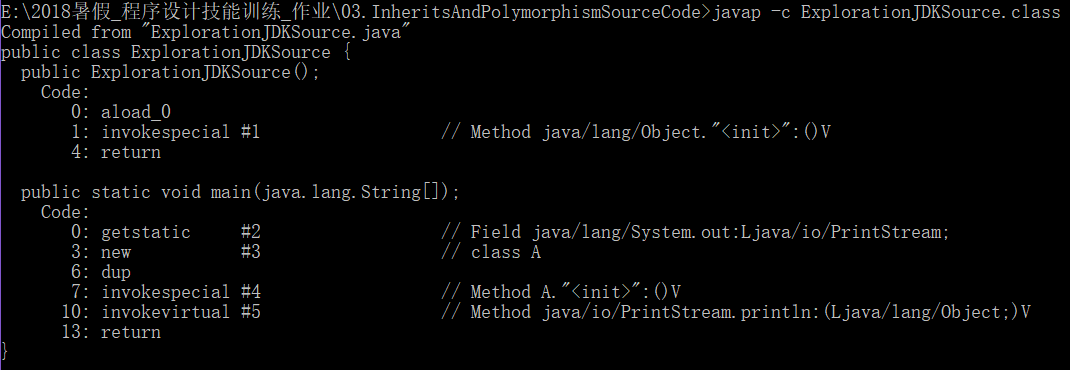(1)继承条件下的构造方法调用
package Demo1; class Grandparent { public Grandparent() { System.out.println("GrandParent Created."); } public Grandparent(String string) { System.out.println("GrandParent Created.String:" + string); } } class Parent extends Grandparent { public Parent() { //super("Hello.Grandparent."); System.out.println("Parent Created"); //super("Hello.Grandparent."); } } class Child extends Parent { public Child() { System.out.println("Child Created"); } } public class TestInherits { public static void main(String args[]) { Child c = new Child(); } }
输出:

结论:
在继承条件下,程序自动先调用父类的构造函数,后调用子类的构造函数。同时,如果使用super调用父类构造方法,必须将函数放在子类方法的第一句。
(2)直接输出类创建的对象
public class ExplorationJDKSource { /** * @param args */ public static void main(String[] args) { System.out.println(new A()); } } class A{}
输出:

根据Javap -c反汇编以上代码:

最后,可根据反汇编追查源码:
System.out.println的源码如下:
public void println(Object x) { String s = String.valueOf(x); synchronized (this) { print(s); newLine(); } }
其中的valueOf源码追查:
public static String valueOf(Object obj) { return (obj == null) ? "null" : obj.toString(); }
toString源码追查:
public String toString() { return getClass().getName() + "@" + Integer.toHexString(hashCode()); }
所以,我们可以明白了为何输出了一串很诡异的字符串。
(3)toString的简单认识
package Demo1; public class Fruit { public String toString() { return "Fruit toString."; } public static void main(String args[]) { Fruit f=new Fruit(); System.out.println("f="+f); System.out.println("f="+f.toString()); } }
输出;

所以,在“+”号运算中,与字符串相连的对象总是默认调用toString方法。
(4)“变态”的多态
package Demo1; public class ParentChildTest { public static void main(String[] args) { Parent parent=new Parent(); parent.printValue(); Child child=new Child(); child.printValue(); parent=child; parent.printValue(); parent.myValue++; parent.printValue(); ((Child)parent).myValue++; parent.printValue(); } } class Parent{ public int myValue=100; public void printValue() { System.out.println("Parent.printValue(),myValue="+myValue); } } class Child extends Parent{ public int myValue=200; public void printValue() { System.out.println("Child.printValue(),myValue="+myValue); } }
输出:

结论:
当子类与父类拥有一样的方法,并且让一个父类变量引用一个子类对象时,到底调用哪个方法,由对象自己的“真实”类型所决定,这就是说:对象是子类型的,它就调用子类型的方法,是父类型的,它就调用父类型的方法。